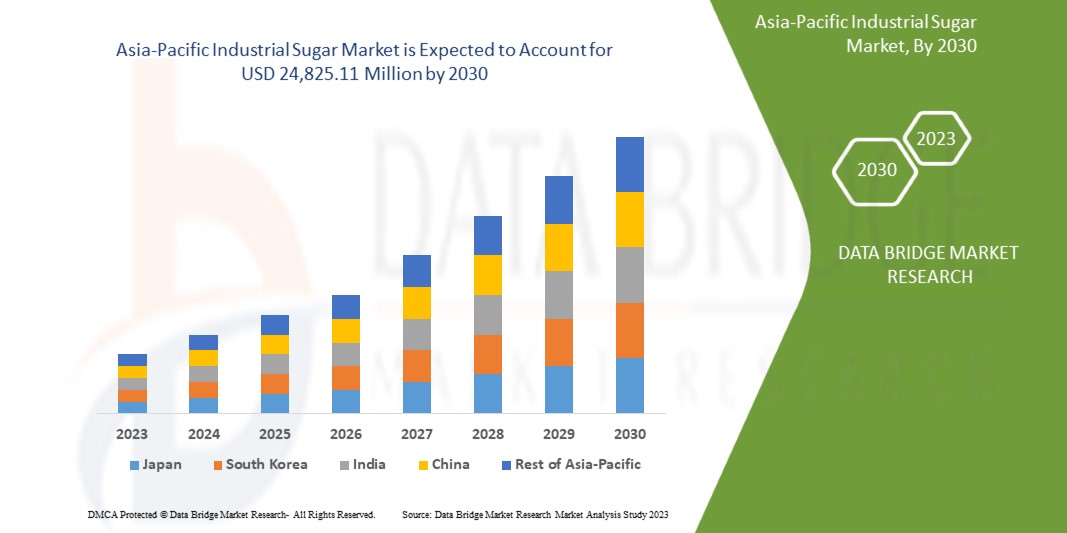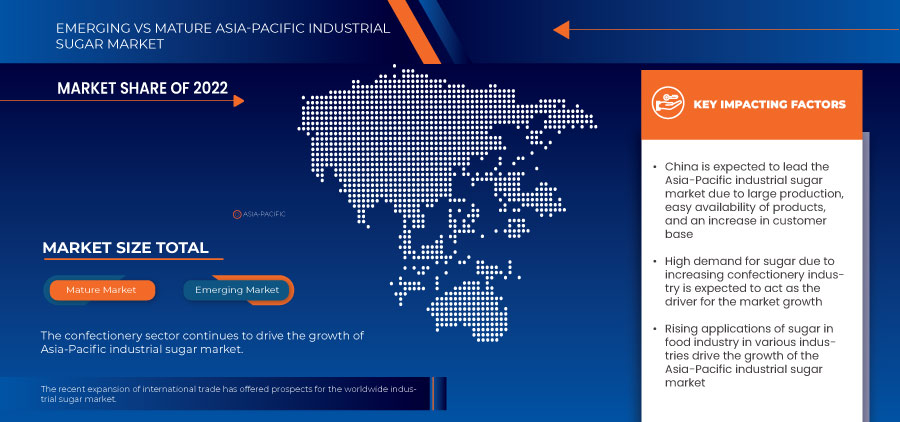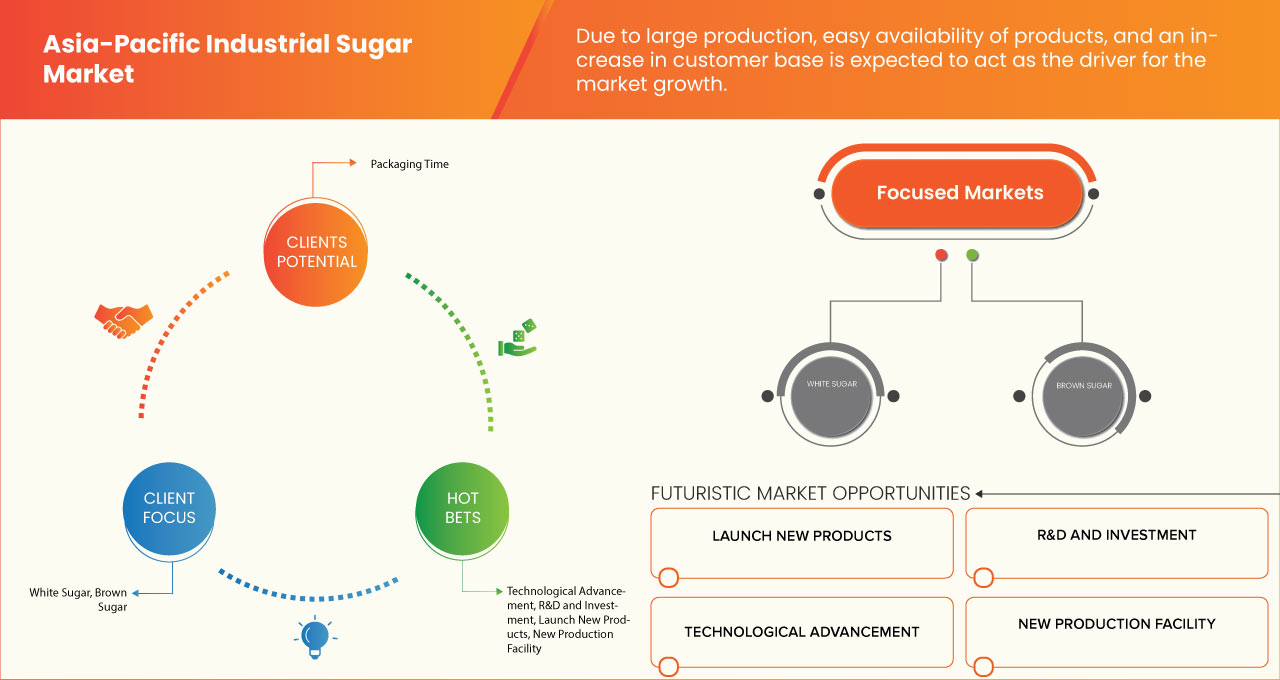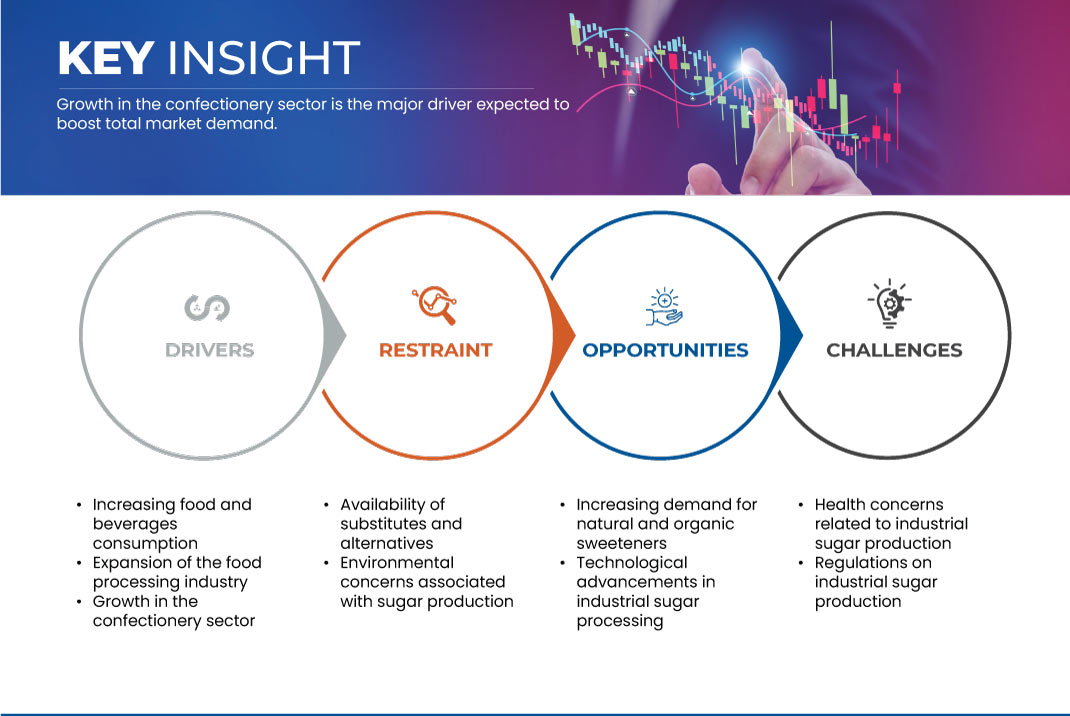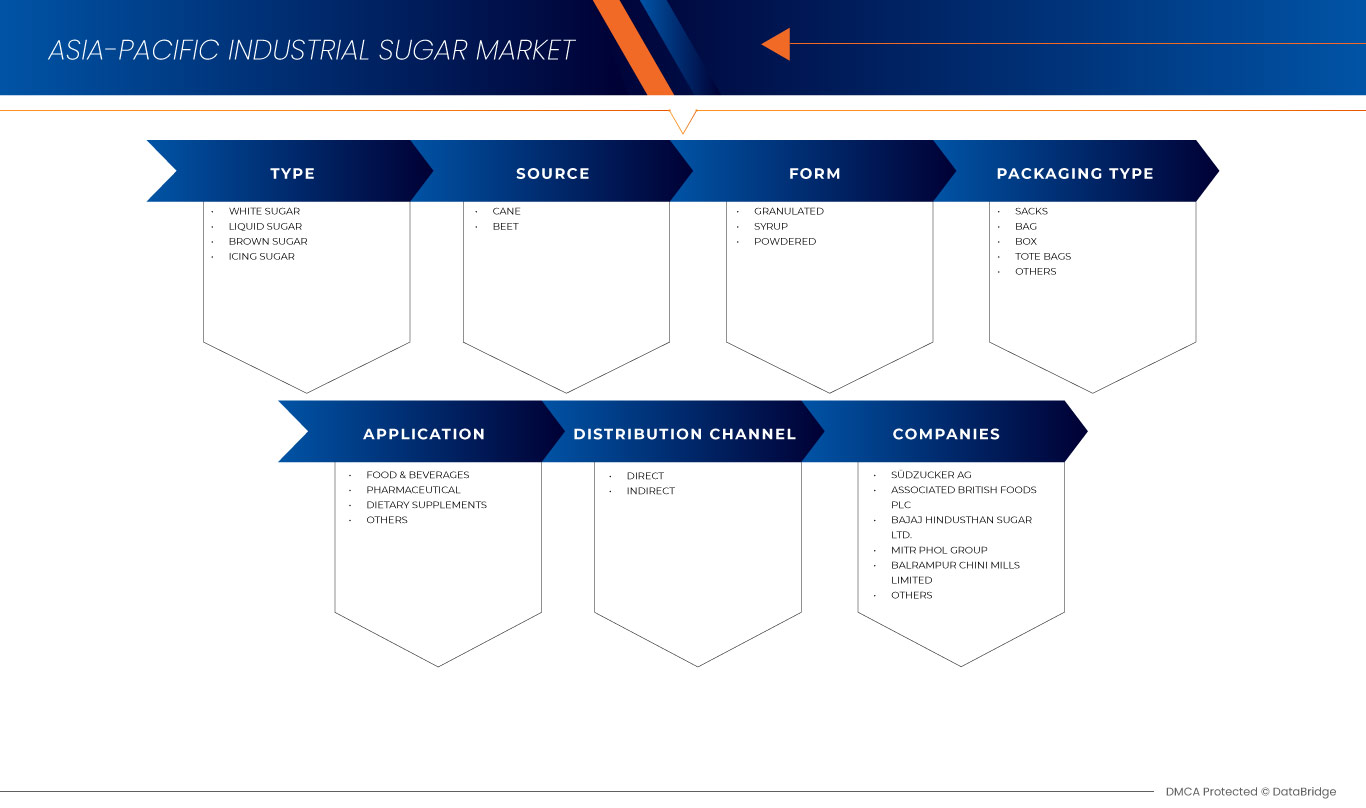Asia-Pacific Industrial Sugar Market, By Type (White Sugar, Liquid Sugar, Brown Sugar, and Icing Sugar), Source (Cane and Beet), Form (Granulated, Syrup, and Powdered), Packaging Type (Sacks, Bag, Box, Tote Bags, and Others), Application (Food & Beverages, Pharmaceutical, Dietary Supplements, and Others), Distribution Channel (Direct and Indirect) - Industry Trends and Forecast to 2030.
Asia-Pacific Industrial Sugar Market Analysis and Size
The Asia-Pacific industrial sugar market is being driven by increasing use of industrial sugar in drinks around the globe along with expansion of food processing industry. In addition, rapid growth in the confectionary sector is likely to fuel the market's growth. Additionally, the increasing adoption use of bio-fuel for production of sugar will open up more business potential for industrial sugar market in the forecast period 2023-2030.
Data Bridge Market Research analyses that the Asia-Pacific industrial sugar market is expected to reach the value of USD 24,825.11 million by 2030, at a CAGR of 3.6% during the forecast period.
|
Report Metric |
Details |
|
Forecast Period |
2023 to 2030 |
|
Base Year |
2022 |
|
Historic Years |
2021 (Customized to 2015-2020) |
|
Quantitative Units |
Revenue in USD Million |
|
Segments Covered |
Type (White Sugar, Liquid Sugar, Brown Sugar, and Icing Sugar), Source (Cane and Beet), Form (Granulated, Syrup, and Powdered), Packaging Type (Sacks, Bag, Box, Tote Bags, and Others), Application (Food & Beverages, Pharmaceutical, Dietary Supplements, and Others), Distribution Channel (Direct and Indirect) |
|
Countries Covered |
India, China, Thailand, Australia and New Zealand, Indonesia, Vietnam, Philippines, Malaysia, Japan, South Korea, Singapore, Taiwan, and Rest of Asia-Pacific |
|
Market Players Covered |
Südzucker AG, Mitr Phol Group, Associated British Foods plc, Bajaj Hindusthan Sugar Ltd., Balrampur Chini Mills Limited, Shree Renuka Sugars Ltd, RANA GROUP, Rajshree Sugars & Chemicals Limited (RSCL), Ragus Sugars Manufacturing Ltd., and Upper Ganges Sugar & Industries Limited among others |
Market Definition
Industrial sugar, additionally referred to as bulk sugar or commercial sugar, is used in a variety of sectors and holds a significant market share. This highly refined sugar is mainly utilized for industrial purposes rather than direct consumption. Its versatile properties and wide range of applications make it an essential ingredient in a variety of industries, fueling a thriving industrial sugar market.
The food and beverage industry is a key application for industrial sugar. It is an essential ingredient in the manufacture of processed foods, confectioneries, beverages, and bakery goods. Industrial sugar's sweetness, texture, and preservative properties improve the taste and overall quality of these products, making them indispensable to manufacturers. Its ability to function as a bulking agent, stabilizer, and flavor enhancer also contributes to its widespread use in the food industry.
Asia-Pacific Industrial Sugar Market Dynamics
This section deals with understanding the market drivers, advantages, opportunities, restraints and challenges. All of this is discussed in detail below:
Drivers
- Increasing Food and Beverages Consumption
Sugary drink consumption has risen as a result of rapid urbanization, which has increased the global consumption of food and beverages. Although refined sugar can be accepted as part of a healthy diet, sweetened drinks are widely advertised, inexpensive, and widely available. They include soft drinks, cordinal, energy drinks, sports drinks, and flavored mineral water. Furthermore, the standard serving size has changed from 375 ml to 600 ml bottles, which has increased the amount of industrial sugar as drink consumption has increased over the forecast period.
Furthermore, the global industrial sugar market has grown significantly in recent years, owing primarily to the increased use of industrial sugar in the beverage industry. Industrial sugar, derived from sugar cane or sugar beet, is used to sweeten a variety of beverages, including carbonated soft drinks, energy drinks, fruit juices, and ready-to-drink beverages. However, emerging economies, such as China, India, and Brazil, have witnessed a surge in beverage consumption due to factors such as rising disposable incomes and urbanization. As these markets expand, there is a corresponding increase in the use of industrial sugar in drinks to cater to the growing consumer demand. Thus, the increasing food and beverage consumption is expected to drive market growth.
- Increasing Adoption of Bio-Fuel for the Production of Industrial Sugar
The use of biofuels in the manufacturing process is undergoing a significant shift in the market. Biofuels are a sustainable replacement for fossil fuels because they are made from renewable resources such as sugarcane bagasse and beet pulp. The expanding food processing, confectionery, and beverage industries are driving up demand for industrial sugar. Traditionally, the machinery and equipment used in the production of sugar have been powered by fossil fuels. But the industry is moving toward the use of biofuels as sustainability and lowering carbon emissions become more important.
The global movement toward environmental sustainability is in line with the uptake of biofuels. Biofuels are regarded as renewable energy sources because they are made from biomass, which is constantly replenishable. The industrial sugar sector can aid in lowering greenhouse gas emissions and preventing climate change by reducing its reliance on fossil fuels. To achieve their sustainability objectives, governments and governing bodies from all over the world are promoting the use of biofuels. Many nations have put supportive policies in place to promote the use of biofuels, including renewable energy targets, tax breaks, and subsidies. With the help of these initiatives, industrial sugar producers can switch to biofuel-powered operations.
As a result, it is expected that the increased use of biofuel in the production of industrial sugar is expected to drive market growth.
Opportunity
- Increasing Demand for Natural and Organic Sweeteners
The worldwide industrial sugar industry is experiencing tremendous growth as a result of technological developments in sugar processing. Sugar processing traditionally relies on conventional methods such as milling, purification, and crystallization. However, advancements in technology have revolutionized the industry, introducing new techniques and equipment that streamline production, optimize resource utilization, and enhance product quality. These advancements are reshaping the global industrial sugar market and creating opportunities for manufacturers to stay competitive in a rapidly changing landscape.
The demand for greater efficiency and lower costs is one of the main forces behind technological developments in the sugar processing industry. Manufacturers may optimize operations, reduce waste, and increase productivity, thanks to sophisticated automation systems, computerized controls, and data analytics. These developments aid sugar producers in lowering production costs and increasing profitability. Sugar producers can improve the quality of their goods and set themselves apart from competitors thanks to technological improvements. Modern processing methods, such as centrifugal separators and continuous vacuum pan systems, provide better control over variables such as crystal size, color, and moisture content. Manufacturers are able to produce high-quality sugar with consistent qualities to satisfy the demands of numerous industries and consumer preferences.
Hence, the key market players are exploring opportunities to develop advancements in production technologies and launching new innovative products, thus offering a wide opportunity for market growth.
Restraint/Challenge
- Availability of Substitutes and Alternatives
The global industrial sugar market is increasingly adopting substitutes and alternatives. This shift is being driven by a variety of factors, including shifting consumer preferences, health concerns, sustainability concerns, and regulatory changes. Sugar cane and sugar beet have traditionally been the primary sugar sources in the industrial sugar market. However, changing market dynamics and consumer demands have prompted the exploration and use of substitutes and alternatives to traditional industrial sugar.
Replicating the flavor and texture of traditional sugar is one of the key considerations in the adoption of substitutes and alternatives for industrial sugar. It is challenging to provide substitutes with the same level of satisfaction as consumers have developed a strong preference for the sensory qualities offered by sugar. In many cases, substitutes have a different flavor profile and might not have the desired sweetness or mouthfeel. There may be obstacles to the widespread adoption of substitutes due to consumer preferences and expectations for taste, quality, and familiarity.
Natural sweeteners such as stevia, monk fruit extract, and agave syrup have gained popularity as sugar substitutes. These sweeteners are perceived as healthier and more natural alternatives, appealing to consumers looking for products with clean labels. Manufacturers are incorporating these natural sweeteners into their formulations to meet consumer demand. Sucralose, aspartame, and saccharin have long been used as sugar substitutes. However, consumer concerns about potential health risks associated with these sweeteners have led to increased scrutiny and caution. Manufacturers must address these concerns and ensure the safety and efficacy of artificial sweeteners to maintain consumer trust.
Recent Development
- In May 2023, Mitr Phol Group announced the launch of new packaging material that is sustainable and eco-friendly. They started to transform the packaging for sugar products into sustainable material due to rising concerns among consumers. This development will help the company to attract a large consumer base.
Asia-Pacific Industrial Sugar Market Scope
The Asia-Pacific industrial sugar market is segmented into six notable segments based on type, source, form, packaging type, application, and distribution channel. The growth amongst these segments will help you analyze major growth segments in the industries and provide the users with a valuable market overview and market insights to help them make strategic decisions for identifying core market applications.
Type
- White Sugar
- Liquid Sugar
- Brown Sugar
- Icing Sugar
On the basis of type, the market is segmented into white sugar, liquid sugar, brown sugar, and icing sugar.
Source
- Cane
- Beet
On the basis of source, the market is segmented into cane and beet.
Form
- Granulated
- Syrup
- Powdered
On the basis of form, the market is segmented into granulated, syrup, and powdered.
Packaging Type
- Sacks
- Bag
- Box
- Tote Bags
- Others
On the basis of packaging type, the market is segmented into sacks, bag, box, tote bags, and others.
Application
- Food & Beverages
- Pharmaceutical
- Dietary Supplements
- Others
On the basis of application, the Asia-Pacific industrial sugar market is segmented into food & beverages, pharmaceutical, dietary supplements, and others.
Distribution Channel
- Direct
- Indirect
On the basis of distribution channel, the Asia-Pacific industrial sugar market is segmented into direct and indirect.
Asia-Pacific Industrial Sugar Market Regional Analysis/Insights
The Asia-Pacific industrial sugar market is analyzed and market size insights and trends are provided by type, source, form, packaging type, application, and distribution channel, as referenced above.
The countries covered in the Asia-Pacific industrial sugar market report are India, China, Thailand, Australia and New Zealand, Indonesia, Vietnam, Philippines, Malaysia, Japan, South Korea, Singapore, Taiwan, and Rest of Asia-Pacific.
India is expected to dominate due large production, easy availability of products and increase in customer base.
The country section of the report also provides individual market impacting factors and changes in market regulation that impact the current and future trends of the market. Data points like down-stream and upstream value chain analysis, technical trends and porter's five forces analysis, case studies are some of the pointers used to forecast the market scenario for individual countries. Also, the presence and availability of global brands and their challenges faced due to large or scarce competition from local and domestic brands, impact of domestic tariffs and trade routes are considered while providing forecast analysis of the country data.
Competitive Landscape and Asia-Pacific Industrial Sugar Market Share Analysis
The Asia-Pacific industrial sugar market competitive landscape provides details by competitor. Details included are company overview, company financials, revenue generated, market potential, investment in research and development, new market initiatives, regional presence, production sites and facilities, production capacities, company strengths and weaknesses, product launch, product width and breadth, application dominance. The above data points provided are only related to the companies' focus on the market.
Some of the major players operating in the Asia-Pacific Industrial Sugar Market are Südzucker AG, Mitr Phol Group, Associated British Foods plc, Bajaj Hindusthan Sugar Ltd., Balrampur Chini Mills Limited, Shree Renuka Sugars Ltd, RANA GROUP, Rajshree Sugars & Chemicals Limited (RSCL), Ragus Sugars Manufacturing Ltd., and Upper Ganges Sugar & Industries Limited among others.
SKU-
Get online access to the report on the World's First Market Intelligence Cloud
- Interactive Data Analysis Dashboard
- Company Analysis Dashboard for high growth potential opportunities
- Research Analyst Access for customization & queries
- Competitor Analysis with Interactive dashboard
- Latest News, Updates & Trend analysis
- Harness the Power of Benchmark Analysis for Comprehensive Competitor Tracking
Table of Content
1 INTRODUCTION
1.1 OBJECTIVES OF THE STUDY
1.2 MARKET DEFINITION
1.3 OVERVIEW OF ASIA-PACIFIC INDUSTRIAL SUGAR MARKET
1.4 CURRENCY AND PRICING
1.5 LIMITATIONS
1.6 MARKETS COVERED
2 MARKET SEGMENTATION
2.1 MARKETS COVERED
2.2 GEOGRAPHICAL SCOPE
2.3 YEARS CONSIDERED FOR THE STUDY
2.4 CURRENCY AND PRICING
2.5 DBMR TRIPOD DATA VALIDATION MODEL
2.6 PRIMARY INTERVIEWS WITH KEY OPINION LEADERS
2.7 DBMR MARKET POSITION GRID
2.8 MULTIVARIATE MODELLING
2.9 TYPE LIFELINE CURVE
2.1 MARKET APPLICATION COVERAGE GRID
2.11 SECONDARY SOURCES
2.12 ASSUMPTIONS
3 EXECUTIVE SUMMARY
4 PREMIUM INSIGHTS
5 MARKET OVERVIEW
5.1 DRIVERS
5.1.1 INCREASING FOOD AND BEVERAGES CONSUMPTION
5.1.2 EXPANSION OF THE FOOD PROCESSING INDUSTRY
5.1.3 GROWTH IN THE CONFECTIONERY SECTOR
5.1.4 INCREASING ADOPTION OF BIO-FUEL FOR THE PRODUCTION OF INDUSTRIAL SUGAR
5.2 RESTRAINTS
5.2.1 AVAILABILITY OF SUBSTITUTES AND ALTERNATIVES
5.2.2 ENVIRONMENTAL CONCERNS ASSOCIATED WITH SUGAR PRODUCTION
5.2.3 WATER SCARCITY AND LAND MANAGEMENT ISSUES
5.3 OPPORTUNITIES
5.3.1 INCREASING DEMAND FOR NATURAL AND ORGANIC SWEETENERS
5.3.2 TECHNOLOGICAL ADVANCEMENTS IN INDUSTRIAL SUGAR PROCESSING
5.3.3 INTERNATIONAL TRADE EXPANSION
5.4 CHALLENGES
5.4.1 HEALTH CONCERNS RELATED TO INDUSTRIAL SUGAR CONSUMPTION
5.4.2 REGULATIONS ON INDUSTRIAL SUGAR PRODUCTION
5.4.3 FLUCTUATING RAW MATERIAL PRICES
6 ASIA PACIFIC INDUSTRIAL SUGAR MARKET, BY REGION
6.1 ASIA-PACIFIC
7 COMPANY LANDSCAPE
7.1 COMPANY SHARE ANALYSIS: ASIA-PACIFIC
8 SWOT ANALYSIS
9 COMPANY PROFILE
9.1 SÜDZUCKER AG
9.1.1 COMPANY SNAPSHOT
9.1.2 REVENUE ANALYSIS
9.1.3 PRODUCT PORTFOLIO
9.1.4 RECENT DEVELOPMENT
9.2 MITR PHOL GROUP
9.2.1 COMPANY SNAPSHOT
9.2.2 PRODUCT PORTFOLIO
9.2.3 RECENT DEVELOPMENT
9.3 ASSOCIATED BRITISH FOODS PLC
9.3.1 COMPANY SNAPSHOT
9.3.2 REVENUE ANALYSIS
9.3.3 PRODUCT PORTFOLIO
9.3.4 RECENT DEVELOPMENT
9.4 BAJAJ HINDUSTHAN SUGAR LTD. (2022)
9.4.1 COMPANY SNAPSHOT
9.4.2 REVENUE ANALYSIS
9.4.3 PRODUCT PORTFOLIO
9.4.4 RECENT DEVELOPMENT
9.5 BALRAMPUR CHINI MILLS LIMITED
9.5.1 COMPANY SNAPSHOT
9.5.2 REVENUE ANALYSIS
9.5.3 PRODUCT PORTFOLIO
9.5.4 RECENT DEVELOPMENT
9.6 RAGUS SUGARS MANUFACTURING LTD.
9.6.1 COMPANY SNAPSHOT
9.6.2 PRODUCT PORTFOLIO
9.6.3 RECENT DEVELOPMENT
9.7 RAJSHREE SUGARS & CHEMICALS LIMITED (RSCL) (2022)
9.7.1 COMPANY SNAPSHOT
9.7.2 REVENUE ANALYSIS
9.7.3 PRODUCT PORTFOLIO
9.7.4 RECENT DEVELOPMENT
9.8 RANA GROUP (2022)
9.8.1 COMPANY SNAPSHOT
9.8.2 REVENUE ANALYSIS
9.8.3 PRODUCT PORTFOLIO
9.8.4 RECENT DEVELOPMENT
9.9 SHREE RENUKA SUGARS LTD (2022)
9.9.1 COMPANY SNAPSHOT
9.9.2 REVENUE ANALYSIS
9.9.3 PRODUCT PORTFOLIO
9.9.4 RECENT DEVELOPMENT
9.1 UPPER GANGES SUGAR & INDUSTRIES LTD. (UGSIL)
9.10.1 COMPANY SNAPSHOT
9.10.2 PRODUCT PORTFOLIO
9.10.3 RECENT DEVELOPMENT
10 QUESTIONNAIRE
11 RELATED REPORTS
List of Figure
FIGURE 1 ASIA-PACIFIC INDUSTRIAL SUGAR MARKET: SEGMENTATION
FIGURE 2 ASIA-PACIFIC INDUSTRIAL SUGAR MARKET: DATA TRIANGULATION
FIGURE 3 ASIA-PACIFIC INDUSTRIAL SUGAR MARKET: DROC ANALYSIS
FIGURE 4 ASIA-PACIFIC INDUSTRIAL SUGAR MARKET: REGIONAL VS COUNTRY MARKET ANALYSIS
FIGURE 5 ASIA-PACIFIC INDUSTRIAL SUGAR MARKET: COMPANY RESEARCH ANALYSIS
FIGURE 6 ASIA-PACIFIC INDUSTRIAL SUGAR MARKET: INTERVIEW DEMOGRAPHICS
FIGURE 7 ASIA-PACIFIC INDUSTRIAL SUGAR MARKET: DBMR MARKET POSITION GRID
FIGURE 8 ASIA-PACIFIC INDUSTRIAL SUGAR MARKET: MARKET APPLICATION COVERAGE GRID
FIGURE 9 ASIA-PACIFIC INDUSTRIAL SUGAR MARKET: SEGMENTATION
FIGURE 10 INCREASING ADOPTION OF BIO-FUEL FOR PRODUCTION OF SUGAR IS DRIVING THE GROWTH OF ASIA-PACIFIC INDUSTRIAL SUGAR MARKET IN THE FORECAST PERIOD OF 2023 TO 2030
FIGURE 11 WHITE SUGAR SEGMENT IS EXPECTED TO ACCOUNT FOR THE LARGEST SHARE OF THE ASIA-PACIFIC INDUSTRIAL SUGAR MARKET IN 2023 & 2030
FIGURE 12 DRIVERS, RESTRAINTS, OPPORTUNITIES, AND CHALLENGES OF THE ASIA-PACIFIC INDUSTRIAL SUGAR MARKET
FIGURE 13 ASIA-PACIFIC INDUSTRIAL SUGAR MARKET: SNAPSHOT (2022)
FIGURE 14 ASIA-PACIFIC INDUSTRIAL SUGAR MARKET: COMPANY SHARE 2022 (%)

Asia Pacific Industrial Sugar Market, Supply Chain Analysis and Ecosystem Framework
To support market growth and help clients navigate the impact of geopolitical shifts, DBMR has integrated in-depth supply chain analysis into its Asia Pacific Industrial Sugar Market research reports. This addition empowers clients to respond effectively to global changes affecting their industries. The supply chain analysis section includes detailed insights such as Asia Pacific Industrial Sugar Market consumption and production by country, price trend analysis, the impact of tariffs and geopolitical developments, and import and export trends by country and HSN code. It also highlights major suppliers with data on production capacity and company profiles, as well as key importers and exporters. In addition to research, DBMR offers specialized supply chain consulting services backed by over a decade of experience, providing solutions like supplier discovery, supplier risk assessment, price trend analysis, impact evaluation of inflation and trade route changes, and comprehensive market trend analysis.
Research Methodology
Data collection and base year analysis are done using data collection modules with large sample sizes. The stage includes obtaining market information or related data through various sources and strategies. It includes examining and planning all the data acquired from the past in advance. It likewise envelops the examination of information inconsistencies seen across different information sources. The market data is analysed and estimated using market statistical and coherent models. Also, market share analysis and key trend analysis are the major success factors in the market report. To know more, please request an analyst call or drop down your inquiry.
The key research methodology used by DBMR research team is data triangulation which involves data mining, analysis of the impact of data variables on the market and primary (industry expert) validation. Data models include Vendor Positioning Grid, Market Time Line Analysis, Market Overview and Guide, Company Positioning Grid, Patent Analysis, Pricing Analysis, Company Market Share Analysis, Standards of Measurement, Global versus Regional and Vendor Share Analysis. To know more about the research methodology, drop in an inquiry to speak to our industry experts.
Customization Available
Data Bridge Market Research is a leader in advanced formative research. We take pride in servicing our existing and new customers with data and analysis that match and suits their goal. The report can be customized to include price trend analysis of target brands understanding the market for additional countries (ask for the list of countries), clinical trial results data, literature review, refurbished market and product base analysis. Market analysis of target competitors can be analyzed from technology-based analysis to market portfolio strategies. We can add as many competitors that you require data about in the format and data style you are looking for. Our team of analysts can also provide you data in crude raw excel files pivot tables (Fact book) or can assist you in creating presentations from the data sets available in the report.

